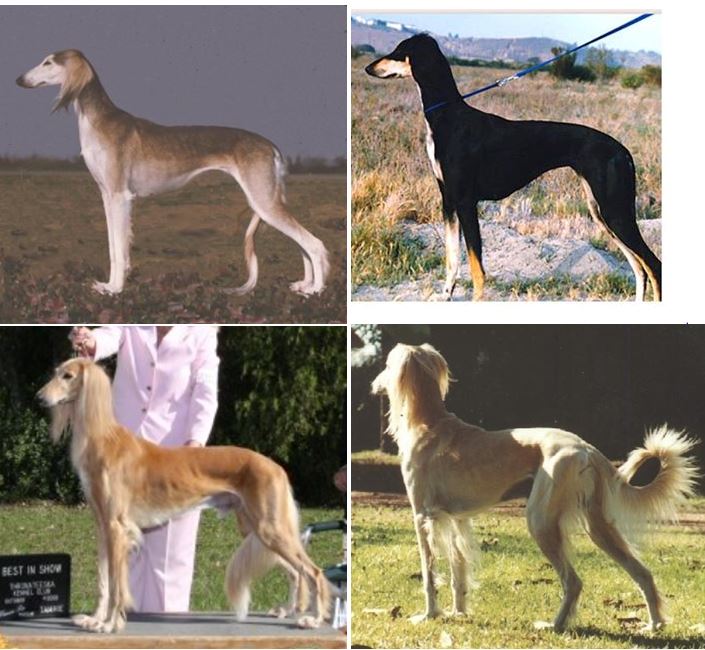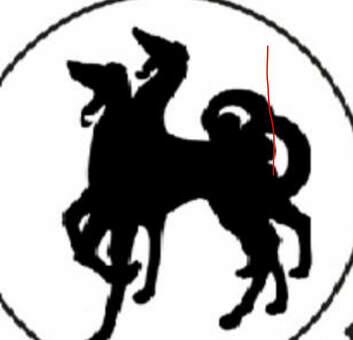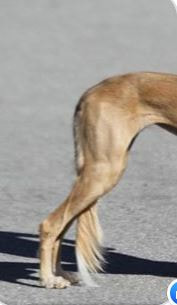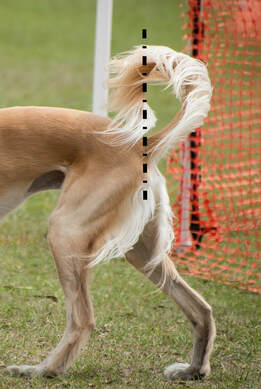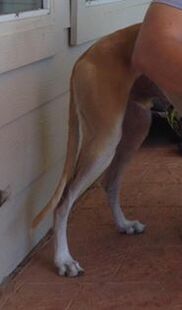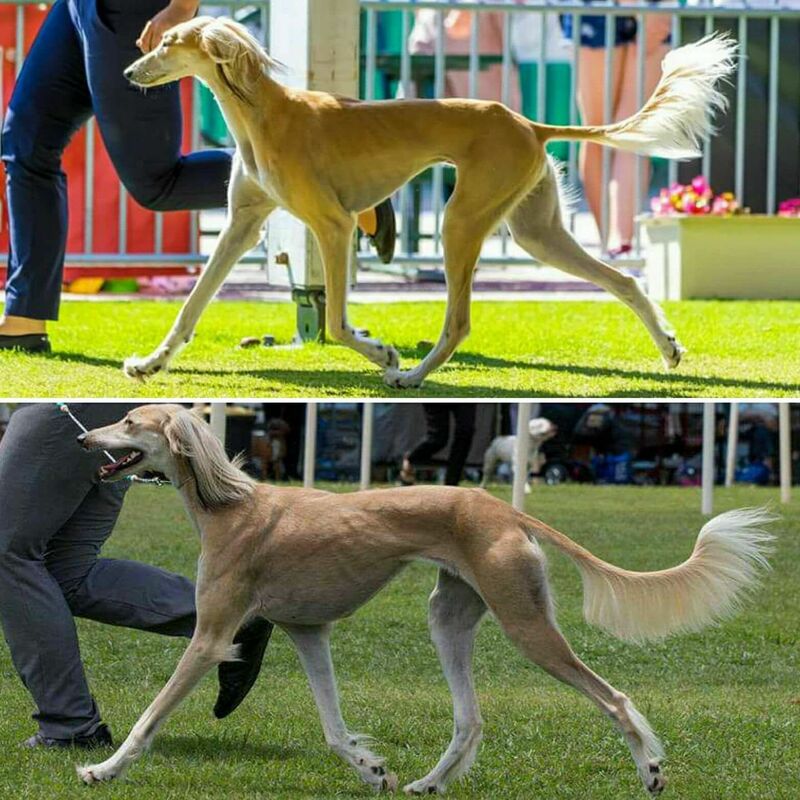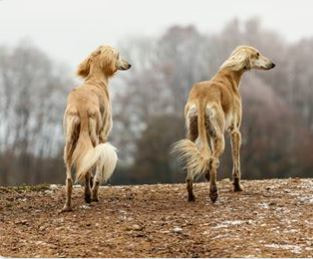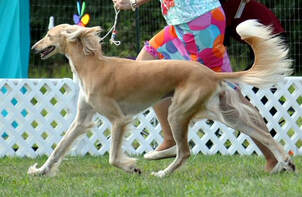Judging the Hindquarters and Tail
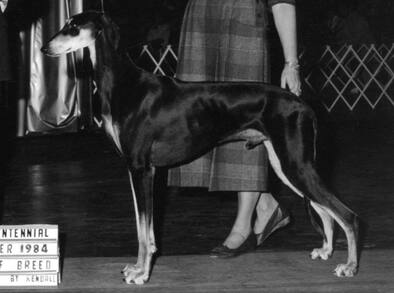
Hindquarters
AKC Standard: Hindquarters: Strong, hipbones set well apart and stifle moderately bent, hocks low to the ground, showing galloping and jumping power.
Croup: Many salukis are either too steep in the croup, resulting in a rear that appears poised on its tippy toes with hocks about to collapse, or too flat, usually associated with a dead flat topline. The black smooth pictured here has an ideal croup.
Thighs: Both first and second thighs should be well-muscled. Muscles need not be bulging like a greyhound, as salukis should have longer flatter muscles of an endurance runner. But they should be hard.
Many salukis have an overly long and thin second thigh, resulting in a weak rear. This is often associated with overly angulated rears.
Salukis have a greater tendency to be over-angulated rather than under-angulated in the rear.
Hocks should be low to the ground.
As in all dogs, the rear feet are smaller than the front but should still be hare footed.
Of the croups below, C and F are too steep; D and especially E too flat; and while A has a bit high tail set and D is a bit steep, they are both within acceptable range.
The four below all have nice croups.
AKC Standard: Hindquarters: Strong, hipbones set well apart and stifle moderately bent, hocks low to the ground, showing galloping and jumping power.
Croup: Many salukis are either too steep in the croup, resulting in a rear that appears poised on its tippy toes with hocks about to collapse, or too flat, usually associated with a dead flat topline. The black smooth pictured here has an ideal croup.
Thighs: Both first and second thighs should be well-muscled. Muscles need not be bulging like a greyhound, as salukis should have longer flatter muscles of an endurance runner. But they should be hard.
Many salukis have an overly long and thin second thigh, resulting in a weak rear. This is often associated with overly angulated rears.
Salukis have a greater tendency to be over-angulated rather than under-angulated in the rear.
Hocks should be low to the ground.
As in all dogs, the rear feet are smaller than the front but should still be hare footed.
Of the croups below, C and F are too steep; D and especially E too flat; and while A has a bit high tail set and D is a bit steep, they are both within acceptable range.
The four below all have nice croups.
Tail
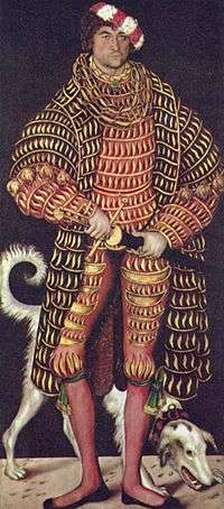 Henry IV with Dog, circa 1500.
Henry IV with Dog, circa 1500.
AKC Standard: Tail: Long, set on low and carried naturally in a curve, well feathered on the underside with long silky hair, not bushy.
Tail set is far more important than tail carriage. You will occasionally see a saluki with a high tail set; it looks like a hot dog is growing out of their spine and into the tail.
More often you will see a saluki with high tail carriage. The standard does not address this. Most breeders don't mind a tail that is carried high, but they do object to one that is carried high and curls forward like a spitz tail or that makes a circle or hits the back. Unfortunately, while not that common, some salukis are shown with "fixed" tails, which may hang like ropes. This is not something you can determined in the ring; that said, be cautious when rewarding a dog whose tail is "dead" over one that is held too gayly.
Other tails are carried tucked tightly under the abdomen. I would far prefer a gay tail to a tucked tail, as in many cases the gay tail is simply the result of a happy dog---and the tucked tail the result of a timid dog. Sometimes handlers will pose these dogs with the tail positioned on the dog's right side, so it doesn't appear to stab the abdomen nor get tangled in the hind legs when starting to move.
Some tails are too short, and this seems to run in some families. The tail should reach at bare minimum to the hock, preferably beyond.
The tail should have a curve to it, and not be carried limp like a rope nor straight out like a setter.
Some tails have kinks, which may be faulty depending on how severe the kink is.
Note the tail carriage of the Salukis in this 1933 film. Some are low, some are high, but all are perfectly acceptable given the mood of the dogs.
Tail set is far more important than tail carriage. You will occasionally see a saluki with a high tail set; it looks like a hot dog is growing out of their spine and into the tail.
More often you will see a saluki with high tail carriage. The standard does not address this. Most breeders don't mind a tail that is carried high, but they do object to one that is carried high and curls forward like a spitz tail or that makes a circle or hits the back. Unfortunately, while not that common, some salukis are shown with "fixed" tails, which may hang like ropes. This is not something you can determined in the ring; that said, be cautious when rewarding a dog whose tail is "dead" over one that is held too gayly.
Other tails are carried tucked tightly under the abdomen. I would far prefer a gay tail to a tucked tail, as in many cases the gay tail is simply the result of a happy dog---and the tucked tail the result of a timid dog. Sometimes handlers will pose these dogs with the tail positioned on the dog's right side, so it doesn't appear to stab the abdomen nor get tangled in the hind legs when starting to move.
Some tails are too short, and this seems to run in some families. The tail should reach at bare minimum to the hock, preferably beyond.
The tail should have a curve to it, and not be carried limp like a rope nor straight out like a setter.
Some tails have kinks, which may be faulty depending on how severe the kink is.
Note the tail carriage of the Salukis in this 1933 film. Some are low, some are high, but all are perfectly acceptable given the mood of the dogs.
Next: Movement
